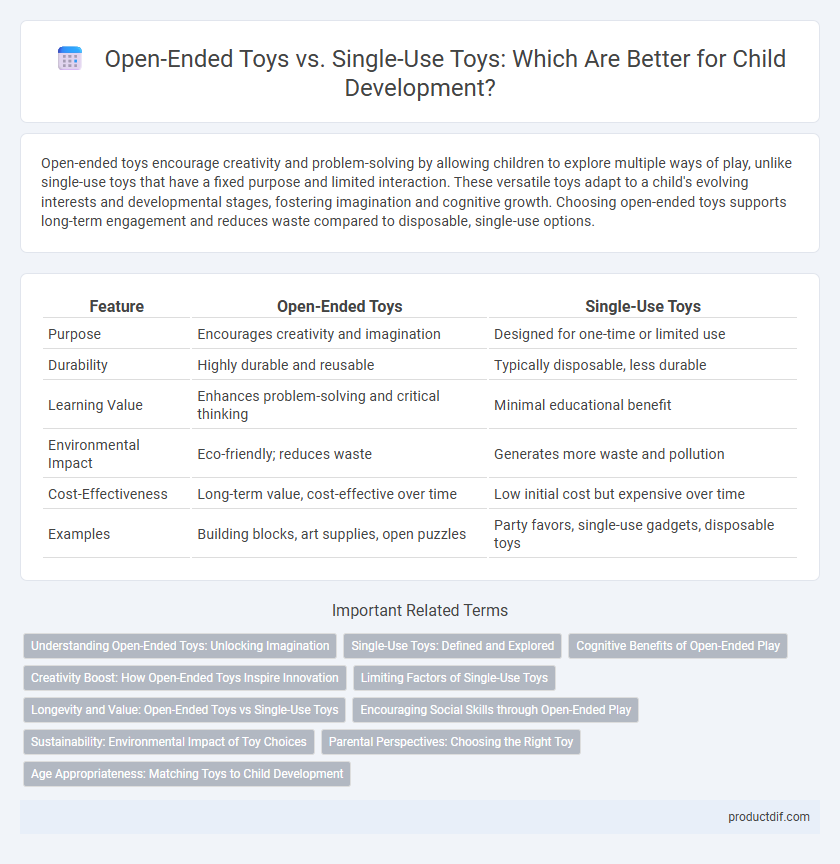Open-ended toys encourage creativity and problem-solving by allowing children to explore multiple ways of play, unlike single-use toys that have a fixed purpose and limited interaction. These versatile toys adapt to a child's evolving interests and developmental stages, fostering imagination and cognitive growth. Choosing open-ended toys supports long-term engagement and reduces waste compared to disposable, single-use options.
Table of Comparison
| Feature | Open-Ended Toys | Single-Use Toys |
|---|---|---|
| Purpose | Encourages creativity and imagination | Designed for one-time or limited use |
| Durability | Highly durable and reusable | Typically disposable, less durable |
| Learning Value | Enhances problem-solving and critical thinking | Minimal educational benefit |
| Environmental Impact | Eco-friendly; reduces waste | Generates more waste and pollution |
| Cost-Effectiveness | Long-term value, cost-effective over time | Low initial cost but expensive over time |
| Examples | Building blocks, art supplies, open puzzles | Party favors, single-use gadgets, disposable toys |
Understanding Open-Ended Toys: Unlocking Imagination
Open-ended toys stimulate creativity and cognitive development by allowing children to use their imagination without predefined outcomes, such as building blocks, art supplies, and dress-up costumes. Unlike single-use toys that provide limited play patterns and quickly lose appeal, open-ended toys encourage problem-solving, storytelling, and social interaction. Research shows that engagement with open-ended toys enhances critical thinking and adaptability, essential skills for lifelong learning.
Single-Use Toys: Defined and Explored
Single-use toys are designed for limited interaction, often focusing on a single function or activity, which restricts creative engagement and rapid playtime exhaustion. These toys typically promote passive entertainment and are less effective in developing problem-solving skills or imagination compared to open-ended toys. The environmental impact of single-use toys is significant due to their disposable nature and limited durability, contributing to increased plastic waste.
Cognitive Benefits of Open-Ended Play
Open-ended toys stimulate critical thinking and creativity by allowing children to explore multiple possibilities and solutions, enhancing problem-solving skills over time. Unlike single-use toys that provide limited interaction, open-ended play supports cognitive flexibility and imagination by encouraging experimentation and innovation. Research indicates children engaged with open-ended toys show improved executive functioning and sustained attention compared to those playing with structured, single-purpose toys.
Creativity Boost: How Open-Ended Toys Inspire Innovation
Open-ended toys stimulate creativity by encouraging children to explore limitless possibilities, fostering critical thinking and problem-solving skills. Unlike single-use toys, which offer predetermined functions, open-ended toys adapt to individual imagination, promoting innovation through hands-on experimentation. This unrestricted play environment cultivates cognitive flexibility and nurtures a lifelong passion for creative discovery.
Limiting Factors of Single-Use Toys
Single-use toys often suffer from limited developmental engagement due to their predefined functions, restricting creativity and problem-solving skills in children. These toys typically lack adaptability, offering a single form of play that diminishes prolonged interest and cognitive growth. Environmental concerns also arise as single-use toys contribute to increased plastic waste and reduced sustainability compared to reusable, open-ended options.
Longevity and Value: Open-Ended Toys vs Single-Use Toys
Open-ended toys offer greater longevity due to their versatile design, enabling children to use them in multiple ways over extended periods. Single-use toys often have limited play value, leading to quick disposal and increased costs over time. Investing in open-ended toys provides lasting value through sustained engagement and reduced environmental impact.
Encouraging Social Skills through Open-Ended Play
Open-ended toys such as building blocks, art supplies, and role-playing sets foster collaboration and communication by allowing children to create and share stories together. Unlike single-use toys with limited functions, these versatile playthings encourage negotiation, empathy, and problem-solving in group settings. Research shows that open-ended play enhances social skills, making it vital for childhood development and peer interaction.
Sustainability: Environmental Impact of Toy Choices
Open-ended toys, crafted from sustainable materials, promote long-term engagement, reducing the need for frequent replacements and minimizing waste in landfills. Single-use toys often contain non-recyclable plastics, contributing significantly to environmental pollution and resource depletion. Choosing open-ended toys supports eco-friendly play by encouraging creativity while lowering the carbon footprint associated with toy production and disposal.
Parental Perspectives: Choosing the Right Toy
Parents often prefer open-ended toys over single-use toys due to their ability to foster creativity, problem-solving, and long-term engagement in children. Open-ended toys like building blocks, art supplies, and pretend-play sets provide versatile learning opportunities and adapt to a child's developmental stages. In contrast, single-use toys offer limited play value, often leading to quick boredom and less meaningful developmental growth.
Age Appropriateness: Matching Toys to Child Development
Open-ended toys, such as building blocks and art supplies, support various developmental stages by encouraging creativity and problem-solving skills adapted to a child's age. Single-use toys often target specific milestones but may limit exploration beyond preset functions, which can restrict developmental growth. Matching toys to age appropriateness ensures children engage with challenges suited to their cognitive, motor, and emotional abilities, promoting continuous learning and skill development.
Open-ended toys vs single-use toys Infographic

 productdif.com
productdif.com